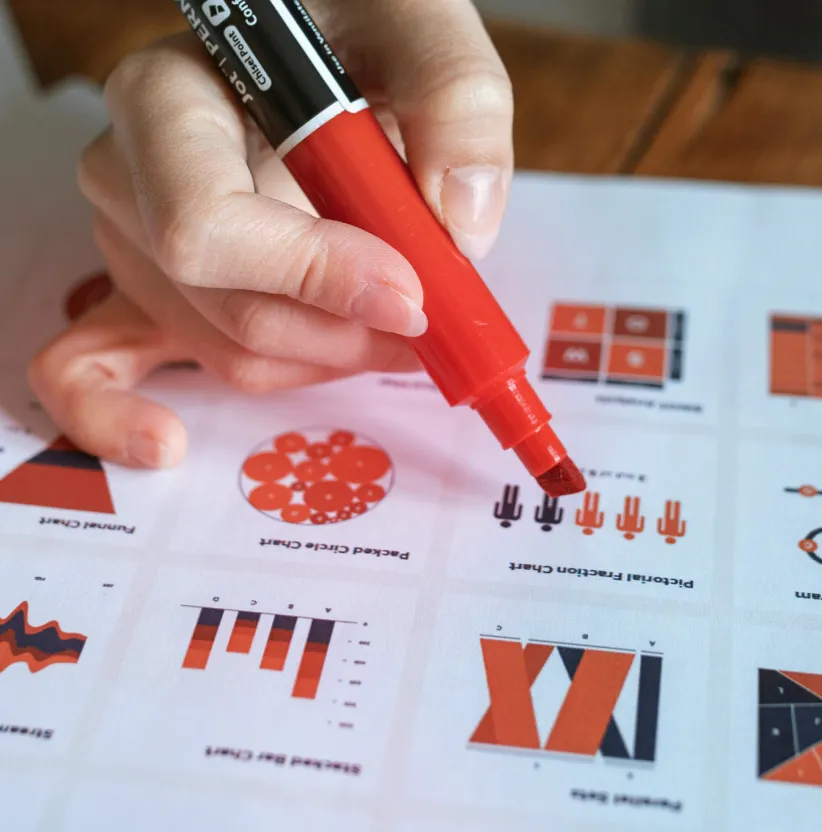5 Reasons Why 90% Of New Tech Products Fail
It doesn’t matter if you’re a product owner looking to launch the next big thing, or a CTO deciding on the viability of a new product; you’re both probably thinking the same question – “How can we create a tech product that customers love?”. However, in a multi-million dollar industry that values a fast-failing-forward approach, you might want to consider a different question – “Why do so many new tech products fail?”
As humans, we’re far more likely to learn from people’s mistakes than emulating what was done right. This article will reverse engineer the (lack of) success of others, so that you can develop a tech product that is celebrated by its stakeholders, embraced by its market and attractive to potential investors.
With that being said, here are the five reasons why 90% of new tech products fail:
- Forgetting the importance of data
- A weak-product market fit
- Poor usability experience
- Barriers to adoption
- A lack of relevant team experience
A Lack of Analytics - Clubhouse
A product is only as good as its data. This is a crucial element that many new product owners (big and small) overlook. Clubhouse launched in March 2020 as an ambitious social network where people could connect through virtual rooms using only their voice. Inspired by the rising global popularity of podcasts and coupled with an invite-only-access launch, the app went viral and became a unicorn-valued product in just nine months.
But where is it now?
What happened to an app that most people don’t even think twice about today?
Within just one year after its launch, Clubhouse suffered a decline of more than 86% of users downloading the app. This can be attributed to one main thing – they forgot the importance of data at a time it was most crucial.
Data for products means defining a clear business model that can guide stakeholders to develop for the user relationships they want to foster. It means being a stickler for analytics so that it can solve the right problems, seeking feedback from customers when a dip in users is noticed, identifying when iteration is needed, and tailoring the essential features for your target market.
The Clubhouse app lacked key analytics around users, creators and rooms. This caused losses in advertising revenue, an unclear path to how the app would become profitable, and difficulties in scaling self-sustaining communities. For the analytics that they did possess such as rising incident complaints, their slow pace at iterating Trust & Safety Policies had users fleeing the app to escape bullying and hate-speech.
If you don’t want your product to become another product failure example, then you need to ask – “What analytics should we be tracking for a successful product development process?”
A Weak Product-Market fit - Google Glass
There are many reasons why new products fail, and even technological frontrunners such as Google aren’t able to avoid them all.
When Google announced the release of this new product, the world was excited. The idea of a hands-free computer in the form of futuristic glasses was something that people thought would be a game changer. However, there were two main shortcomings of the Google Glass. Released in May 2014, it failed to consider the market’s technical limitations, and it failed to position it as a socially acceptable device to wear.
The Google Glass was marketed as a wearable that would transform how we accessed the internet. But at $1500 a piece, its other-wordly price and futuristic design seemed only fitting for the exorbitantly rich (or tech-loving Trekkies). With a short battery life, poor display resolution and limited processing capabilities, this futuristic concept had technical capabilities that were no more impressive than a server system from the 90s. The luxury positioning may have created a buzz, but the reality of the product left luxury expectations falling flat.
Perhaps if this cyborg looking wearable had been launched in the era of TikTok influencers and creators, it may have been better embraced by the market. However, with the cost being inaccessible for most, the design being too unusual to hold appeal, and the functionality falling short of what their users would have required, the Google Glass no longer exists as a product for us to question whether it was simply before its time, or whether it never had a chance at success at all.
Weak product-market fit is the cause for 35% of new product failures. When trying to avoid a product launch failure, you need to first assess the problems or needs of your market and determine if they even want a product like that launched in the first place. Once you’ve established that, carry out market research that can answer the following – “What fundamental expectations will our market have for our product, and how do we meet them?”
Poor Usability Experience - The Microsoft Band
If you can establish a strong product-market fit, you’re already one step ahead. But this added advantage doesn’t mean that your product is completely safe from failure. Developing a product that customers love is just as much about market fit, as it is about usability.Which brings us to another technological giant that created a product that didn’t quite live up to its potential – The Microsoft Band.
Launched in October 2014, its uncomfortable design, inaccurate heart-rate tracker, and overcomplication of features, resulted in a product that users grew to dislike. Positioned to rival other leading sports bands, the Microsoft band failed to be swim-resistant, user-friendly, and capable of holding a charge that would cater to a real athlete’s needs.
Good usability goes beyond just enabling a positive user experience however. Good usability enables a positive customer experience by reducing the number of complaints and the cost of employees having to troubleshoot barriers to adoption.
When considering your product development process, you want to consider it in light of usability functions that are aligned with user intent, accessible for diverse needs, and with an interface that is intuitive enough to allow efficient user navigation. Products with usability that is seamless and logical to the user are more likely to be products that survive the dreaded 90% product-failure rate.
If you’ve read up to this point, you now know 3 of the 5 key reasons why so many new products fail. The next two you are about to read however, are probably the most important of them all.
Too Many Barriers to Adoption- Windows Vista
Whenever you’re exploring something new and different, your first experience of it should be straightforward, seamless, and without impeding obstacles to adoption. If product owners and product developers don’t take this into consideration, your good product can fail just as quickly as a bad one.
This is exactly what happened with Windows Vista.
Released in November of 2006, the Windows Vista was poised to be the sexy replacement of Windows XP – with greater efficiency, security, and reliability than any of its predecessors. But, the reality of what it could do fell far short of its promises. Embarrassingly, it became spoken about in tech circles as one of Microsoft’s greatest failures.
But why exactly did it fail? Well, because Vista was discriminately slow.
Unless you were able to squander thousands on expensive hardware upgrades that could cater to its heavy code stuffed with numerous detailed features, your machine would simply buckle under the weight of software bloat. This made the product too costly to adopt, and too inefficient to integrate.
Microsoft also underestimated how deeply rooted Windows XP had become with its following. With 80% of computers using Windows XP, everyone ranging from IT companies to average-Joe computer users, didn’t feel the need to inconvenience themselves and make a transition to something entirely new. This was especially true because the existing Windows XP had a proven track record of functionality and ability to run on hardware that was cheap and cheerful.
The final reason that Windows Vista failed was because of compatibility issues. And this goes far beyond it being better suited to expensive systems. Part of Vista’s marketing spiel was focused on an increased sense of security. However, the integration of their “Trustworthy Computing Program” led to restrictions that were so limiting, Vista couldn’t be used with older peripherals.
Knowing how to develop a successful product is based largely on actively avoiding the common mishaps of the many examples of product failures. If your product has too many barriers to adoption, such as cost or ease of transition, your product is immediately at risk of failure.
Which brings us to the final reason why 90% of products fail, and perhaps one of the most crucial ways to not only prevent failure, but also to guarantee the ability of pivoting to ensure success.
Contextual Team Experience - Industry Insights from Busy Rebel
With 15 years of enterprise experience, our company Busy Rebel has witnessed that many products that fail upon launch, or fail to launch at all, are as a result of insufficient or ill-matched team experience.
But what exactly does that look like?
If you are looking to develop a product, or you think you may need to pivot in your current product development process, these are the four characteristics to determine if your team is equipped to build a product that customers love:
- Your team possesses more than just theoretical expertise. They have a proven track-record of being able to interpret analytics and make decisions that are best for the product, even when that may contradict traditional suggestions.
- Your team is able to interpret customer feedback within context, and adapt the product accordingly to better fit the product-market needs and demands.
- Your team is able to identify shifts in market dynamics, such as loyalty to specific processes or systems that your product would need to be compatible with. This means your team develops the product consciously ensuring that there are minimal barriers to adoption.
- Your team has a strong internal dynamic of clear communication with key stakeholders, so that the usability of the product is aligned with the vision of how core functions should perform.
Is Product Failure Ever 100% Avoidable?
This article has focused on the mistakes of tech giants because of three specific reasons:
- Failure is always more widely spoken about with products from companies that are at the top of their industries
- The data we can gather from the failures of giants is more comprehensive than the data made publicly available by smaller companies, product owners, and product developers
- We wanted to use companies that had the budget-resilience to bounce back from failure, so you can learn all the ways to prevent the same mistakes, at a fraction of the cost
We wrote this article as a guide for all those at the beginning of their product development journey, or for those that have already started but still have unanswered questions. However, the list we’ve covered within this article is not a full-proof solution to avoiding the 90% product-failure-rate. Every product is different, and failure could simply come down to external factors such as poor timing or poor marketing around the product.
If you’re looking to develop a tech product that is celebrated by its stakeholders, embraced by its market and attractive to potential investors, perhaps you want to explore the option of product strategy consulting. From emerging technologies integration to product lifecycle management, our consulting services have resulted in more than $200 million in funding secured for partners.
There is no such thing as ‘guaranteed product success’, but with the right guidance and expertise, your product can come pretty close.
FAQs
How long does it take to build an app prototype?
Answering this question has no single answer. The time it takes to develop an app prototype all depends on how complex the functionalities need to be. This means it could take anywhere from a few days to a few weeks. In order to find out what side of the timeline your prototype will fall on, you should create a detailed feature list, have clarity on the scope of the app, and have a list of all the non-negotiable requirements that the prototype should fulfil.
How much does it cost to build a tech product?
The average tech product has four components that influence its price: cost of development, cost of talent, product complexity, and costs associated with marketing and distribution. Our team of over 40 experts have built products with budgets ranging from $80k – $1M. If you don’t know where to start in estimating your costs associated with these four areas, get a quote with our product design and development service.
What is lean product development ?
The method of lean product development was built upon the Toyota Production System (TPS), created by Taiichi Ohno. It has two main goals:
- To eliminate any parts of the development process that will result in waste
- To optimise efficiency with automation wherever possible
This is achieved through five main principles:
- Iteration should be rapid in reflection of prototyping and user-testing based feedback.
- Efficiency and effectiveness is an ongoing process, and improvement is continuous by nature.
- The development process should be mapped according to how value should be generated, where high-potential areas for bottlenecks and delays should be eliminated early on.
- Functional is favoured over fancy. If the functionality doesn’t correspond to a core value of the product, you need to question if it’s worth keeping.
- Collaborative communication between all key departments is essential in eliminating silos in the process.






